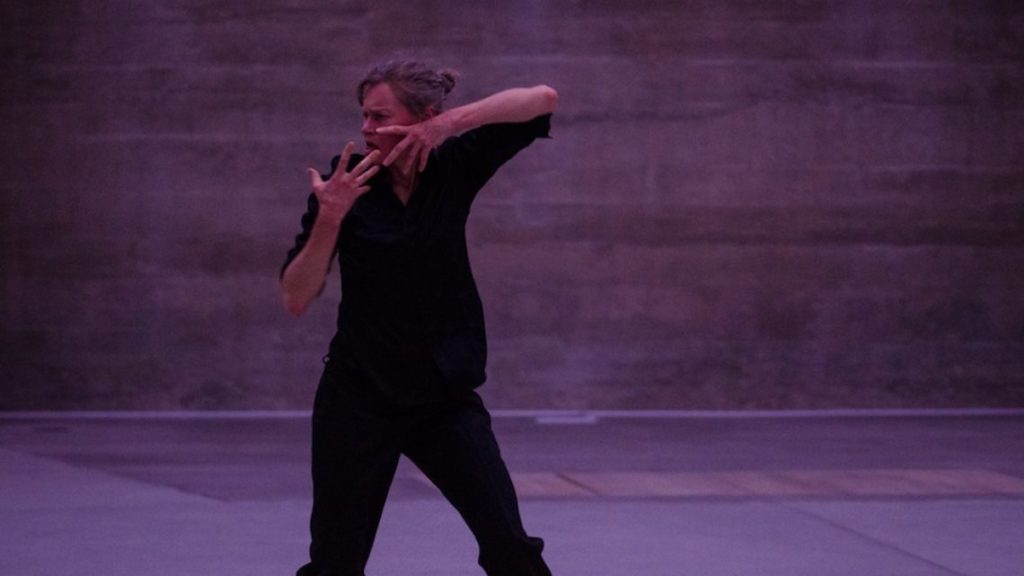
Rosalind Crisp, a world-renown dancer and choreographer, is at Chapter Arts Centre preparing for her performance Unwrapping Danse. She is originally from Australia, where she is active in raising awareness on the environmental catastrophe of the deforestation of the bushes. She divides her time between Australia and Europe, especially France where she has been awarded the highest recognition in the country as Chevalier de l’Ordre des Arts et Lettres. She is generous with her time and allows us to have a long discussion on her approach to dance.
Crisp’s approach to dance is a radical awareness of one’s body and one’s movement. It requires rigorous and lengthy training to undo what the body has learned over the years. All our bodies learn movement, which becomes habitual and unchallenged. Some of us find themselves stuck with bad posture, shallow breathing, or stiff muscles. It takes training to undo the bad habits. For dancers, it is the dance training that becomes habitual and impedes development artistically but also personally. A culture of dancing as perfecting a technique means the dancer will never be good enough. It is a culture of lack.
Crisp explains,
“the training in dance is part of the education paradigm we know in schools where you’re constantly trying to get better, not quite good enough, even when you get really good. … Classical ballet which is where I started is really embedded in that culture of lack, you’re always in a relationship of lack. You never actually get there. This has huge impact on the identity of the dancer. It’s very hard to find your way in dance because it’s uncomfortable and people who dance feel insecure because they’re not good enough. … I think it was partly to do with dealing with that, that turned me away from set movements.”
Crisp focuses on paying close attention to what the body does without us being conscious of it. She is interested in the dancers’ attention to their own bodies and their decision-making in how they choose the next movement. She began with herself, observing and challenging her movements and how she chose movements. She says,
“I trained myself to pay attention. The training is in the attention to where things are emerging in the body, what’s already emerging, especially in the beginning of movement,” she moves her arm as she says so. She says, “I’m more and more interested in what produces a movement than the movement itself.”
I suggest that it’s a bit like meditation. It’s a ‘mindful movement.’
“Paying attention,” Crisp says, “It’s not natural movement. It’s two things: it’s a lot of rigorous work of what compositional choices are available, how fast that moves, how much tension or tone is in that, how much space, which body parts are involved and which aren’t.”
Crisp wanted to shake off the history of dance training, which establishes patterns of movements in the body of dancers.
She says,
“They start to do this movement and you know where it’s gonna go. It’s gonna go to there because the body remembers, like I know how to pick up a sandwich and eat it. … There’s a lot of alertness to the decision-making that is historical or embedded and unquestioned. There’s a constant kind of negotiation. Sometimes that needs softness and support because it’s a very strong, you said that before, mind…?”
“Mindful,” I say, “like in meditation. When you meditate you observe the thoughts in your mind and become aware of them and their patterns.” She tells me,
“it’s about degrees of awakeness to the potential for any part of the body anytime to initiate [movement].”
Then she says something beautiful. She says,
“I think the body is an orchestra not an instrument. Every bit has the capacity to being engaged and they all need to be on standby all the time.” Making the body an orchestra requires paying attention. It’s not letting go, but rigorous observation and training.”
She says,
“It’s not natural movement. It’s two things: it’s a lot of rigorous work of what compositional choices are available, how fast that moves, how much tension or tone is in that, how much space, which body parts are involved and which aren’t.”
She tells me that she tries to put her choreographic mind in the background so that she can pay attention to what’s emerging in the body. She says,
“There’s a sort of decolonising the choreography’s dominance telling the dancer what to do, my choreography. I try to reverse it.”
I suggest that it is a form of authenticity, an awareness of conditioning and the search for something of value. She is not having it. It’s all trickery, she says, but to me her effort to become deeply aware of the body and learned movement resonates with existentialist philosophy and Crisp herself is strikingly authentic. However, I’m conscious that authenticity in performance is associated with the semi-therapeutic and spiritual dramaturgy of Grotowski in theatre and the Authentic Movement in dance. Crisp’s dancing does not aim to be therapeutic or spiritual; rather it is in some way heuristic.
It all began with dancing, just dancing without following set movements. She says,
“dancing, not trying to remember steps but dancing and it was out of years and years of dancing in the studio on my own that I started to be able to notice times when I was having so much fun and it felt like it was like opening a whole world and a new kind of thing.”
Crisp’s approach to dancing is genuinely open. It is radical freedom.
(First published on Groundwork Pro)
